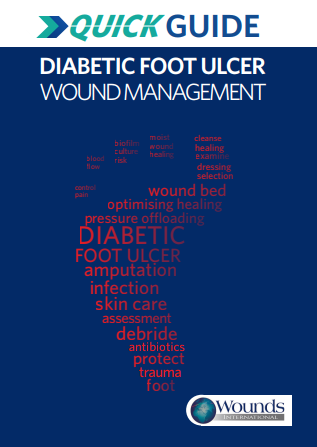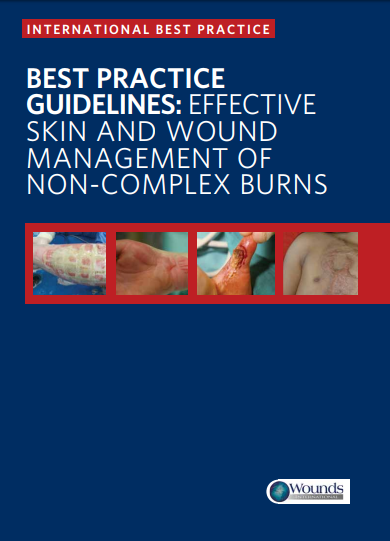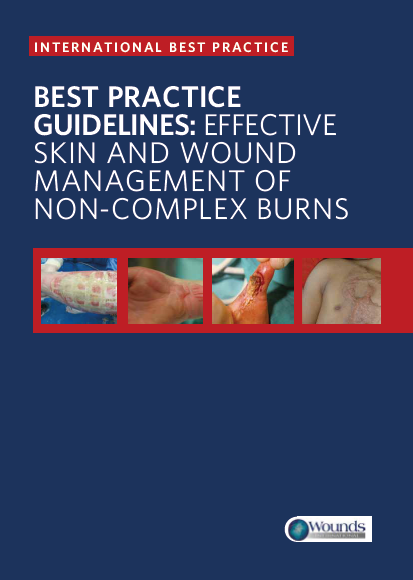Diabetic foot ulcer wound management Quick Guide

The Diabetic Foot Ulcer Wound Management Quick Guide comprises: A review of the TIME framework to optimise wound management A management plan for each step of DFU care to avoid amputation A visual guide to DFU classification and decision-making overview for local wound treatment. Supported by B Braun
Ten Top Tips… Preventing orthopaedic surgery-related wound blisters
<p>Superficial wound blisters are an abnormal swelling (i.e. filling with fluid) in the epidermal layer of the skin in response to trauma. Blistering in postoperative wounds may be caused by skin stripping from removal of medical tape, or prolonged exposure of the skin to adhesive contact layers of dressings and associated with the presence of […]
Ten Top Tips… Understanding and managing wound biofilm
<p>Our understanding of the factors that delay wound healing continues to improve through advances in research into the microenvironment. There is now strong evidence that biofilm is present in the majority of chronic wounds. The pathogenesis of biofilms continues to be evaluated, but current knowledge suggests they are detrimental to wound healing and degrade the […]
Pyoderma gangrenosum associated with melanoma
<p>Pyoderma gangrenosum – a rare, neutrophilic dermatosis – is associated with diseases including inflammatory bowel disease, arthritis and haematologic disease. This case story describes an unusual association between pyoderma gangrenosum and malignant melanoma. Clinicians should consider malignant melanoma in all patients with pyoderma gangrenosum.</p>
Sciatic nerve block: A useful procedure for diabetic foot surgery
<p>The range of comorbidities experienced by people who require lower-limb surgery to manage diabetic foot disease are many. These comorbidites make the undertaken of general anaesthesia both difficult and places them at high risk of complications during surgery or in the immediate postoperative period. In this article the authors present a description of a peripheral […]
Ten Top Tips… Using negative pressure wound therapy effectively
<p>Negative pressure wound therapy (NPWT) has revolutionised the approach to complex wounds, enabling a breakthrough in wound management.Drawing on current research-based evidence and expert consensus opinion, the following top 10 tips can be used to aid appropriate use for optimal outcomes.</p>
Adapting policies and guidelines makes good sense
<p>It has been an absolute pleasure to work with the members of the International Wound Infection Institute (IWII) committee who have produced two of the articles included this issue of Wounds International.</p>
International Wound Infection Institute: Leaders in wound infection understanding, prevention, and management
<p>Wound infection is a source of morbidity and mortality the world over; be it in acute wounds, or the ever-growing number of chronic wounds. Much remains to be done by the clinicians in the field and researchers in the lab to better understand and manage wound infection. Though common, the nuances of many of the […]
New Zealand’s 2013 STOP Pressure Injury Day Campaign: Successes of the New Zealand Wound Care Society
<p>New Zealand faces many of the same issues as other countries around the world with an aging population, increasing numbers of chronically sick patients, and tight health care cost constraints. This is true of wound care, and here the authors report a campaign to address avoidable pressure injuries.</p>
Best practice guidelines: Effective skin and wound management in non-complex burns

This document is a practical guide to the management of burn injuries for healthcare professionals everywhere who are non-burns specialists. With an emphasis on presenting hands-on and relevant clinical information, it focuses on the evaluation and management of non-complex burn injuries that are appropriate for treatment outside of specialist burns units.
Best practice guidelines: Effective skin and wound management in non-complex burns

This document is a practical guide to the management of burn injuries for healthcare professionals everywhere who are non-burns specialists. With an emphasis on presenting hands-on and relevant clinical information, it focuses on the evaluation and management of non-complex burn injuries that are appropriate for treatment outside of specialist burns units.
Infographic on pressure ulcer prevention
Biatain® Silicone dressings: A case series evaluation
<p>A multicentre case series was performed as a product evaluation of two new silicone wound dressings, Biatain® Silicone and Biatain® Silicone Lite (Coloplast A/S, Humlebaek, Denmark). This addressed the dressings’ overall usability (focusing on comfort for the patients and dressing handling for the healthcare practitioners) in a total of 39 patients who fulfilled the evaluation […]
Ten top tips from Wounds International in 2014
<p>Wounds International is delighted to announce that we are now averaging over 50 000 visitors to the website each month from 150 different countries. In October and November 2013, we recorded a large jump in our figures, mainly due to the interest created around the International Wound Care Conference held in Kuala Lumpur, Malaysia in […]
February 2014 Volume 5 Issue 1: Full Issue
An online practice-based journal for clinicians worldwide
Ten Top Tips… The management of burn wounds
<p>Many people will experience a burn injury in their lifetime. Burn injuries range from the most severe – requiring high levels of critical care and surgical intervention – to simple burns, for which self-treatment may suffice. Burn injuries pose a considerable burden to heathcare resources across the globe.[1] In the UK, the figures are considerable, […]
Book review: A Closer Look At Silver: A Clinical Information Tool (CIT) To Help You Choose The Right Silver Wound Dressing For Your Patient!
<p>The cost-effective, efficient management of individuals with wounds is a key factor in providing quality wound management services. Whereas this espoused principle may seem relatively straightforward, in reality it is not. A lack of evidence to support dressing use, along with a lack of sustained availability of the right dressing for the right patient, often […]
Implementing evidence-based leg ulcer care in an Azorean healthcare centre
<p>The Azores are a Portuguese territory and comprise nine volcanic islands situated in the North Atlantic Ocean. The largest and most populous island in this archipelago is São Miguel, which is famous for its beautiful lakes and green mountains.</p>
Ten Top Tips… Taking high-quality digital images of wounds
<p>"Use a picture. It's worth a thousand words."</p>
Ten Top Tips… Promoting your wound care centre
<p>In many countries, health care is largely provided by private sector businesses. Elsewhere, traditionally state-run health services are currently undergoing a shift – not least due the burden of providing care for aging populations – towards the provision of specific health services by the private sector (see, for example, physiotherapy and podiatry in the UK).</p>
Early post-op swelling and its association with lymphoedema
<p>Background: Arm lymphoedema is a commonly recognised complication of breast cancer treatment and can cause major physical and psychological morbidity. Accurate assessment is important and it has been shown that early treatment can minimise the severity of chronic lymphoedema.</p>n<p>Aims: This study investigates the incidence of arm oedema in 133 women who had been treated for […]
30-month post-breast cancer treatment lymphoedema
<p>Background: Quantification of lymphoedema (LE) has been problematic, and the reported incidence of LE varies greatly among women treated with surgery and radiation for breast cancer. Aims: This study aims to describe LE occurrence over time among breast cancer survivors using four diagnostic criteria based on three measurement techniques. Methods: Limb volume and symptom assessment […]
Eliminating LF: a progress report from Tanzania
<p>Lymphatic filariasis (LF) is endemic throughout the United Republic of Tanzania. The figures for Tanzania mainland show that 34 million people are at risk of infection and it is estimated that 6 million people have debilitating manifestations of the disease. The endemicity varies from being highly endemic along the coast with antigenemia levels of 45–60%, […]
The case for intermittent pneumatic compression
<p>Intermittent pneumatic compression (IPC) is widely used to prevent deep vein thrombosis (DVT), yet IPC appears to have application to a broader base of lymphatic and venous disease. The intermittent nature of pulsatile external compression results in beneficial physiologic changes, including haematologic, haemodynamic, and endothelial effects. Application of IPC is a valuable adjunct to the […]
Managed clinical networks: future for LE service provision
<p>The Lymphoedema Network Northern Ireland (LNNI) was designed as a managed clinical network to ensure the best use of scarce resources across institutional boundaries. This facilitates work within and between the five regional trusts across Northern Ireland, including sharing of best practice and service improvement projects, working towards a modern, proactive and efficient service. The […]
Lipoedema: poor knowledge, neglect or disinterest?
<p>At the 3rd International Lymphoedema Framework (ILF) conference in Toronto, an attempt was made to begin to try to address this issue. Over thirty people attended a lipoedema workshop run by the author. In this workshop, I had the opportunity to talk to this international group (Canada, USA, Netherlands, Australia, UK, Germany) who shared their […]
Using yoga in breast cancer-related lymphoedema
<p>The aim of this article is to explore the research findings that can inform the use of yoga for women with breast cancer-related lymphoedema (BCRL). Women with this condition may need lifelong treatment and have to self-manage the affected area. A growing body of research has led to the development of guidelines for the inclusion […]
The use of low level light therapy in the treatment of head and neck oedema
<p>The focus of this article is to present evidence supporting the use of low level laser therapy (LLLT) as a specialist treatment for patients with head and neck oedema. Information obtained from a critique of relevant literature will be utilised to discuss the treatments available for those with head and neck oedema, highlighting how outcomes […]
Lymphoedema Association of Australia
<p>The Lymphoedema Association of Australia (LAA) was founded in 1982 by Drs John and Judith Casley-Smith. The society includes patients, practitioners, allied healthcare professionals, carers and partners. The stated philosophy has been that this association was ‘formed to help each and every one of you’. The LAA previously ran lymphoedema treatment training sessions for both […]
A case for specialist practice
<p>The International Society of Lymphology (ISL) consensus document (2003) and the Lymphoedema Framework (LF) consensus document (2006) provide guidelines to support Best Practice for lymphoedema management. In extreme cases, such guidelines may require creativity and modification to suit patients’ needs. This case report shows the treatment and support needed to assist a patient with gross […]
Case for investment in neglected tropical diseases
<p>Over the last year, we have witnessed a plummeting global economy, one so distressed that it is hard to point at any one thing — real estate, a company, a commodity — that can hold real value and pay dividends. That sort of instability makes it a great time to be in global public health. […]
Society update Vol 4, No 2
<p>- The Lymphoedema Association of Australia (LAA) – The Australasian Lymphology Association (ALA) – The Lymphology Association of North America (LANA) – The Israel Lymphedema Association – Scandinavian Forum of Lymphedema – British Lymphology Society – Lymphoedema Support Network – The Leg Club – MLD UK – The Global Alliance to Eliminate Lymphatic Filariasis (GAELF) […]
Care of palliative patients with cancer-related lymphoedema
<p>Care of the lymphoedema patient with advanced malignant disease requires specific attitudes, modified treatment approaches and a redefinition of the goals of care. This article reviews the factors that can produce oedema in advanced cancer, outlines some key medical and psychosocial issues that can impact lymphoedema treatment in the palliative population, and suggests how standard […]
Managing oedema and fibrosis with coordinated movement
<p>It is generally accepted that lymphoedema and fibrosis can lead to impaired mobility. This will generally lead to a process of adaptation and changes in the neuro-motor system and motor activity. These changes can lead to degenerative processes in the articular and muscular structures, resulting in reduced mobility, inactivity, pain, loss of function, all of […]
Using indocyanine green fluorescent lymphography to demonstrate lymphatic architecture
<p>Background: Visualisation of the lymphatic system is a challenging task. Recently, an indocyanine green (ICG) fluorescent lymphography system was developed for visualising the lymphatic vessels. ICG emits energy in the near-infrared region between 840 and 850 nm when it is bound to protein in the tissue.</p>n<p>Aim: To use ICG fluorescent lymphography to identify locations of […]
Breast cancer treatment, BMI, post-op swelling/lymphoedema
<p>Background: Diagnosis of post-breast cancer lymphoedema is difficult because of inconsistent measurement approaches, measurement reliability and validity, and lymphoedema definition and criterion. Aims: To examine lymphoedema occurrence using a body mass index (BMI)-adjusted limb volume change (LVC) as a potentially sensitive alternative criterion for assessment and diagnosis of lymphoedema. Secondary aims were to examine the […]
Cutaneous infections in lymphoedema
<p>The typical diagnosis of skin infection in patients with lymphoedema includes erysipelas and cellulitis, but the true picture is more complex with the possibility of secondary complications such as lymphadenitis (adeno-lymphangitis) and lymphangitis. The recent description of acute inflammatory episodes (or AIEs) has gone some way to explaining how a patient may be prone to […]
Cellulitis treatment for people with lymphoedema: UK audit
<p>Background: A group of UK clinicians (under the auspices of the British Lymphology Society [BLS] and the Lymphoedema Support Network [LSN]) drew up consensus guidelines on the management of cellulitis in patients with lymphoedema in 2005 (available at: <a href="http://www.thebls.com" target="_blank">www.thebls.com</a>). Aims: To determine whether the guidelines were being followed and to assess the effectiveness […]
ALFP to update the Best Practice document
<p>The Best Practice for the Management of Lymphoedema document (Lymphoedema Framework, 2006) has made a significant impact on the quality of lymphoedema care in the United Kingdom and worldwide. The International Lymphoedema Framework (ILF) has partnered with the American Lymphedema Framework Project (ALFP) to update and expand the 2006 edition to incorporate recent advancements and […]
Placebo controlled trial of mild electrical stimulation
<p>Background: To find ways to improve lymph flow especially when it is hot and or dry/humid when lymph loads are higher than normal. Aims: To determine if mild electrical stimulation of the epifascial compartment of lymphoedema limbs can improve lymphatic drainage when used in conjunction with garments. Methods: Patients were entered into a self-maintenance group […]
A practice guideline for the management of lymphoedema
<p>Management and treatment options for lymphoedema in Japan have traditionally varied between different healthcare institutions. The authors of this article have developed guidelines to standardise treatment of lymphoedema patients, based on scientific evidence. Consensus methods based on the Delphi technique were used when formulating the guidelines. A literature search was conducted and a clinical guideline […]
Unproven concepts needing correlation and further study in lymphoedema
<p>Lymphoedema is a chronic medical condition and a range of questions remain regarding its aetiology, pathophysiology, and management. In this article, the author discusses a range of unproven concepts in lymphoedema and draws attention to some possible mechanisms. The author also produces some hypotheses on which to base some experiments.</p>
Arm symptoms and QoL in Japanese breast cancer patients
<p>Background: Post-operative arm complications among breast cancer patients are relatively underestimated in clinical settings, but the symptoms may affect quality of life (QoL). Aims: To assess the relationships between lymphoedema symptom-related variables and QoL among Japanese women with breast cancer who had undergone surgery. Methods: A cross-sectional postal survey investigated the = relationships between post-operative […]
A time for international collaboration
<p>This is an important time in the work of the International Lymphoedema Framework (ILF) as the conference at Ascot comes to fruition. This event will bring together many of the international groups who are working to improve the lives of patients with lymphatic disorders. Delegates at the conference are coming from around the world. This […]
Lymphoedema in bariatric patients
<p>Obesity continues to rise in Western and developing countries and the prevalence of morbid obesity in the US has reached 5% (Arterburn et al, 2005). Obesity is linked to leg oedema, and morbid obesity certainly appears to be a factor in the development of chronic venous insufficiency (CVI), a condition seen in many patients with […]
Australasian Lymphology Association
<p>The Australasian Lymphology Association (ALA) strives to promote excellence in all aspects of lymphoedema and other oedemas across Australasia. From primary to secondary lymphoedema, paediatrics to geriatrics, from the genetic development of the lymph system, to clinical-based assessment and treatment, the ALA has been instrumental in the recognition of this condition. Areas including education, committees […]
Helping patients self-manage their lymphoedema
<p>This paper describes a matrix of service delivery for patients. The aim at each level is empowerment. The matrix describes five groups of patients with differing levels of lymphoedema complexity. The final group includes two groups of patients; those whose lymphoedema requires surgical intervention and children with lymphoedema. Treatment is used to facilitate the development […]
Star of track and field remains undefeated by lymphoedema
<p>Deborah Cordner was a college track and field star, with a promising athletics career ahead of her when, in her third year at college, after a lump in her groin was removed she developed lymphoedema. She was told she should give up her training altogether but, despite this, she decided that lymphoedema would not get […]
Getting the pressure right: how do we know?
<p>The lymphatic system is a low-flow, low-pressure system, with the latter generally remaining in single figures, but occasionally rising to 40–50 mmHg when blocked. These low pressures – coupled with the delicate nature of even the collecting lymphatics, their location, and the relatively few muscular and structural elements in their walls – mean that the […]
An opportunity to learn, discuss and share experiences
<p>Welcome to the autumn edition of the journal. It gives me great pleasure to introduce the first International Lymphoedema Framework (ILF) Conference that will be taking place at the Ascot conference centre, near London, from the 21st to the 23rd April, 2009. This is an important event in the calendar of the ILF project, as […]


